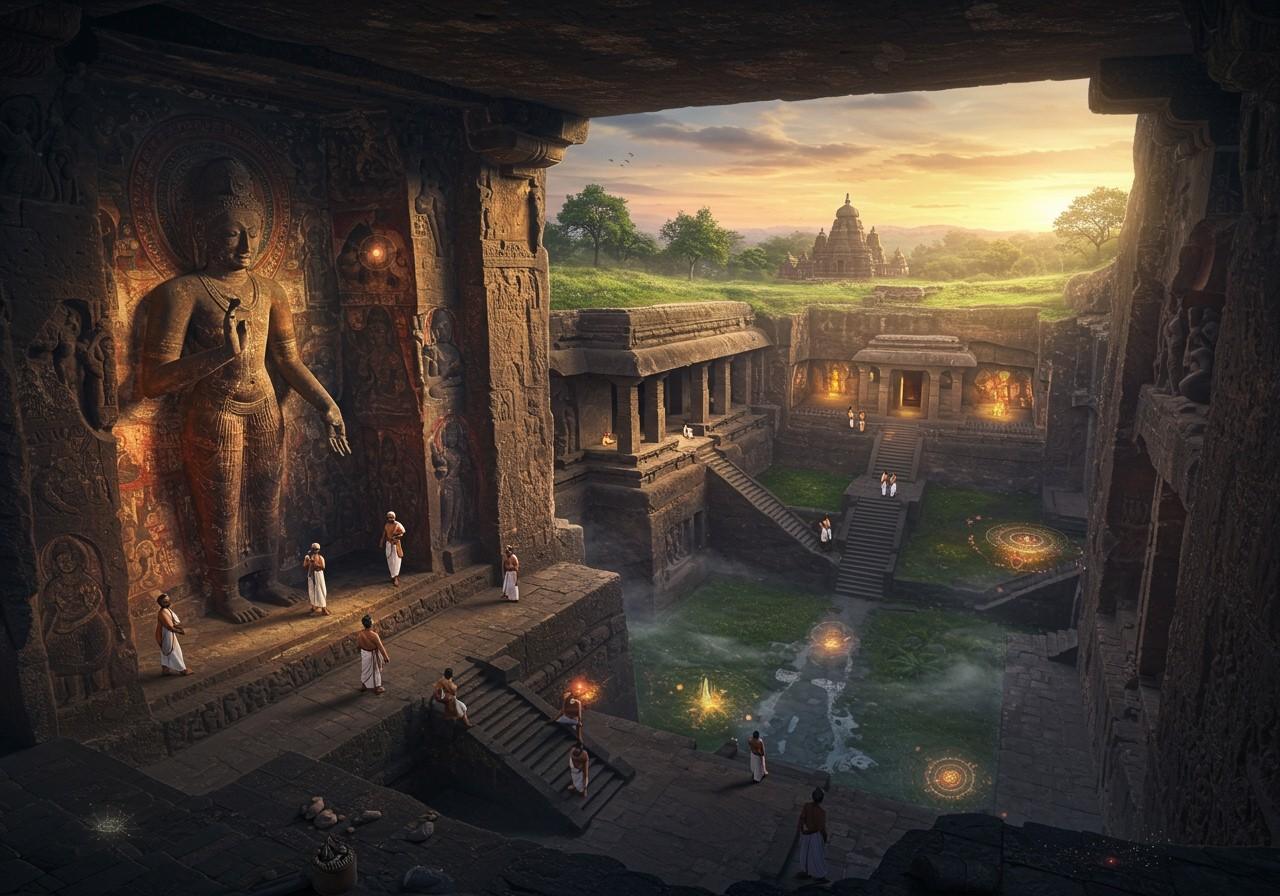
The Vakataka dynasty, originating in the Deccan in the mid-3rd century CE, holds a significant place in Indian history due to its rich cultural contributions. This era, spanning from the 3rd to 5th centuries CE, saw advancements in art, architecture, literature, and religious practices, leaving an enduring legacy on India’s cultural landscape. The Vakatakas maintained strong ties with the Gupta Empire, a relationship that further enriched their cultural development.
A Flourishing of Arts and Literature
The Vakatakas were renowned patrons of the arts and literature. The magnificent Ajanta Caves, a UNESCO World Heritage site, stand as a testament to their artistic vision. Specifically, Caves 16 and 17, commissioned by Vakataka rulers, showcase breathtaking murals depicting Jataka tales and scenes from Buddhist literature. These masterpieces, created using natural pigments and innovative techniques, set a precedent for future artistic traditions in India. Beyond visual arts, the Vakatakas also nurtured classical Sanskrit literature, with prominent figures like the poet Kalidasa flourishing during their reign.
Architectural Marvels
The Vakataka dynasty’s architectural achievements are equally impressive. The rock-cut caves of Ajanta exemplify their mastery of structural engineering and intricate carving. Their architectural style, influenced by the Gupta period, is characterized by elaborate ornamentation and the use of stone. This distinctive style significantly impacted Indian temple architecture, with notable examples like the Mandhal and Ramtek temples showcasing the dynasty’s architectural prowess. Their influence extended to other significant sites such as the Ellora and Elephanta Caves, further solidifying their architectural legacy.
Religious Harmony and Practices
The Vakataka period witnessed the flourishing of both Buddhism and Hinduism. Vakataka rulers actively supported the construction of Buddhist monasteries and stupas, reflecting their patronage of the faith. Their art frequently depicted Buddhist themes, including the life of Buddha and Bodhisattvas. Simultaneously, Hinduism also thrived, with syncretic practices allowing for the harmonious coexistence of both religions. Royal figures, such as Queen Prabhavati Gupta, played a crucial role in promoting religious activities and temple construction. Inscriptions from this era provide valuable insights into the religious life of the Vakataka people.
A Legacy That Endures
The cultural contributions of the Vakataka dynasty have had a lasting impact on Indian art, architecture, and religious practices. Their artistic innovations and architectural principles influenced later traditions, shaping the cultural landscape of central India. Today, modern scholars and cultural institutions work to preserve and study Vakataka sites, ensuring that their rich heritage continues to be appreciated and understood.
How Poojn.in Connects You to Vakataka Heritage
Poojn.in, India’s leading online store for cultural goods and services, offers a unique opportunity to connect with the rich traditions of the Vakataka era. We provide a curated selection of authentic puja items that reflect the artistic and religious practices of this period.
-
For Temple Worship: Experience the reverence of Vakataka temple rituals with our collection of pure copper and brass aarti thalis, reminiscent of the metalwork of that time. We also offer traditional cotton vastras and angavastrams inspired by ancient temple sculptures, along with authentic camphor and dhoop made from natural ingredients, just as they were used in historical temple ceremonies. Complete your puja experience with handcrafted puja bells, similar to those found in Vakataka-era temples. Explore our collection of traditional puja items.
-
For Shiva Worship: Honor Lord Shiva, a prominent deity during the Vakataka period, with our selection of rudraksha malas, bilva leaves, pure copper abhishek items, and traditional bhasma (sacred ash). Find everything you need for Shiva puja here.
-
For Buddhist Practices: Embrace the Buddhist traditions that flourished during the Vakataka era with our range of meditation cushions, pure brass incense holders, organic incense sticks, and prayer beads. Discover our Buddhist puja essentials.
At Poojn.in, we are committed to providing high-quality, authentic puja items that allow you to connect with India’s rich cultural heritage. Visit www.poojn.in to explore our complete collection.
Frequently Asked Questions About the Vakataka Dynasty
What were the significant artistic achievements of the Vakataka Dynasty? The Vakataka Dynasty’s artistic legacy is primarily defined by the exquisite sculptures and murals found within the Ajanta Caves. These works of art frequently depict religious narratives, scenes from daily life, and intricate decorative patterns, showcasing the artistic skill and cultural values of the time.
What was the architectural style of the Vakataka Dynasty? The Vakataka Dynasty made significant contributions to architecture, particularly through rock-cut caves, temples, and monasteries. The Ajanta Caves stand as a prime example of their architectural prowess. Their style, influenced by the Gupta period, often incorporated elaborate carvings, stone construction, and intricate ornamentation.
Which religions were prevalent during the Vakataka Dynasty’s rule? Both Hinduism and Buddhism flourished during the Vakataka period. The dynasty’s rulers extended their patronage to both faiths, leading to the construction of temples, monasteries, and stupas. This era was marked by religious harmony and syncretic practices, where elements of both religions coexisted and influenced each other.


